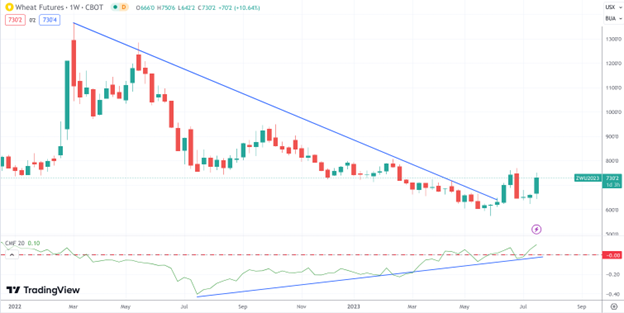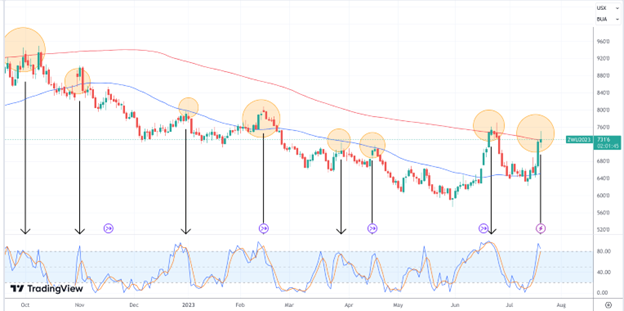What happened: Russia bombed several grain silos in Ukraine, disrupting the country’s ability to export wheat.
More detail on the news event and context: In the Ukrainian port city of Odesa early on July 18, Russian missiles damaged grain terminals and port infrastructure. The Ukrainian government said that the strikes had destroyed about 60,000 tons of wheat and critical infrastructure.
The bombing of Ukraine grain is a major blow to the country’s economy. Ukraine is a major exporter of wheat, and the strikes could lead to higher prices for wheat in other countries. The strikes also have a significant impact on global food security. Ukraine is one of the world’s largest exporters of wheat, and the bombing could lead to food shortages and famine in some countries.
Why it matters: The bombing could lead to higher prices for wheat in other countries, as Ukraine is a major exporter of the crop.
What’s next: Wheat futures prices have already risen in response to the bombing, and they could continue to rise if the situation in Ukraine does not improve.
In a nutshell: Russia’s bombing of Ukraine’s grain silos could drive up wheat futures prices, making it more expensive for people around the world to get the food they need.
What to anticipate: The bombing could lead to higher prices for bread, pasta, and other wheat-based foods. But it can also have a ripple effect on other food prices, as wheat is a major ingredient in many foods.
Fundamental Factors to Consider
Here are a few additional factors that could affect the impact of the bombing on the wheat futures market:
- The extent of the damage to Ukraine’s wheat infrastructure.
- The ability of Ukraine to export wheat through other routes.
- The demand for wheat from other countries.
- The overall state of the global economy.
The Technical Picture
Let’s take a weekly view of wheat futures (ZW) going back to 2022.

Wheat prices spiked in March 2022 as a direct result of Russia’s invasion of Ukraine. SInce then, wheat prices have been steadily falling. Note that the Chaikin Money Flow (CMF) began showing a divergence with prices starting in July of 2022.
CMF is an indicator used to analyze money flow and buying/selling pressure. In the case above, we see buying pressure steadily rising and breaking above the zero line in March 2023. The impact of Russia’s grain deal withdrawal and the subsequent bombing of Ukrainian grain silos can be clearly seen. But how likely is it to be sustained (from a technical analysis perspective)?
Let’s take a look at a daily view chart of the same time period.

Going back to October 2022, note how each Stochastic Osciallator reading at 80 corresponds with wheat prices touching either the 200-day simple moving average (SMA) or the 50-day SMA.
The positioning of the SMA’s, with the 50-day below the 200-day, confirms the bearish price trend. But the market’s response to these levels are remarkably pronounced.
This suggests that wheat prices are being driven by technical factors rather than fundamental ones. The rallies that followed Russia’s withdrawal from a grain deal and the bombing of grain silos—both of which add to increasing uncertainty—were blunted by technical factors (specifically the 200-day SMA) as the fundamental scenario remains to be seen.
So, if you’re planning to trade this scenario, it’s important for you to closely monitor the fundamental and political situation on the ground while keeping a close eye on technical readings.
The Bottom Line
Russia’s bombing of Ukraine’s grain silos has severely impacted Ukraine’s economy and raised concerns about global food security. The destruction of grain silos disrupts Ukraine’s wheat exports, potentially leading to higher prices for wheat worldwide. Wheat futures prices have already risen, reflecting market sensitivity. However, the full impact depends on factors such as the extent of damage, alternative export routes, global demand, and the overall economic situation.
Technical analysis suggests that wheat prices are currently being influenced by technical factors more so than fundamentals. It may remain this way until the fundamental and political picture unfolds with greater clarity.
Please be aware that the content of this blog is based upon the opinions and research of GFF Brokers and its staff and should not be treated as trade recommendations. There is a substantial risk of loss in trading futures, options and forex. Past performance is not necessarily indicative of future results.
Disclaimer Regarding Hypothetical Performance Results: HYPOTHETICAL PERFORMANCE RESULTS HAVE MANY INHERENT LIMITATIONS, SOME OF WHICH ARE DESCRIBED BELOW. NO REPRESENTATION IS BEING MADE THAT ANY ACCOUNT WILL OR IS LIKELY TO ACHIEVE PROFITS OR LOSSES SIMILAR TO THOSE SHOWN. IN FACT, THERE ARE FREQUENTLY SHARP DIFFERENCES BETWEEN HYPOTHETICAL PERFORMANCE RESULTS AND THE ACTUAL RESULTS SUBSEQUENTLY ACHIEVED BY ANY PARTICULAR TRADING PROGRAM.
ONE OF THE LIMITATIONS OF HYPOTHETICAL PERFORMANCE RESULTS IS THAT THEY ARE GENERALLY PREPARED WITH THE BENEFIT OF HINDSIGHT. IN ADDITION, HYPOTHETICAL TRADING DOES NOT INVOLVE FINANCIAL RISK, AND NO HYPOTHETICAL TRADING RECORD CAN COMPLETELY ACCOUNT FOR THE IMPACT OF FINANCIAL RISK IN ACTUAL TRADING. FOR EXAMPLE, THE ABILITY TO WITHSTAND LOSSES OR TO ADHERE TO A PARTICULAR TRADING PROGRAM IN SPITE OF TRADING LOSSES ARE MATERIAL POINTS WHICH CAN ALSO ADVERSELY AFFECT ACTUAL TRADING RESULTS. THERE ARE NUMEROUS OTHER FACTORS RELATED TO THE MARKETS IN GENERAL OR TO THE IMPLEMENTATION OF ANY SPECIFIC TRADING PROGRAM WHICH CANNOT BE FULLY ACCOUNTED FOR IN THE PREPARATION OF HYPOTHETICAL PERFORMANCE RESULTS AND ALL OF WHICH CAN ADVERSELY AFFECT ACTUAL TRADING RESULTS.